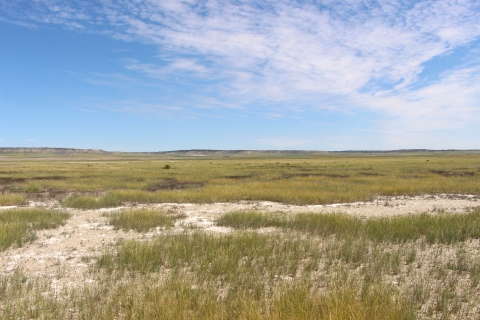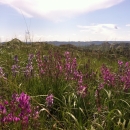About Us
Hailstone National Wildlife Refuge is a 160-acre Refuge located in Stillwater County roughly 5-miles east of Rapelje, Montana. Surrounded on three sides by the 1,828-acre Hailstone Waterfowl Production Area (WPA), both the Refuge and WPA lie in the Lake Basin area and are jointly managed together as one unit. The Refuge and WPA provide habitat for resident bird species such as greater sage-grouse and singing grassland songbirds such as western meadowlarks, which abound here.
Both the WPA and Refuge serve as an important staging, feeding, and nesting area for migrating waterfowl, shorebirds, and other migratory birds in spring through early summer. Migratory bird species that may be present include mountain plover, and lark sparrow. The Refuge and WPA provide habitat for resident species such as pronghorn antelope and mule deer and has supported a colony of black-tailed prairie dogs (a state species of concern) in the past. Prairie dogs are notoriously susceptible to plague which can completely wipe out a colony; sometimes colonies can recover over time. The piping plover is a federally threatened bird species that may also use the Refuge or the WPA, but its use has not been confirmed.
Greasewood grows in the saline soils whereas native grasses flourish in less saline areas. Many small mammals exist within the Refuge and WPA, along with horned lizards (often referred to as horned toads), and rattlesnakes. These shortgrass prairie habitat species all complement each other.
Over the years, heavy metals such as selenium and salts accumulated in the reservoir and surrounding soil due to natural evaporation. The elevated salt and selenium levels degraded the water quality and created an unacceptable risk to waterfowl and shorebirds. In 2011, the earthen dam was removed to re-create a free flow through system. Before the dam of Hailstone Reservoir was breeched, it depended primarily on precipitation, runoff from lands in the watershed above, and Hailstone Creek to fill it.
Seldom (once per decade or two) is there adequate flows to flush the reservoir basin. The only water currently available for prolonged wildlife use is in two small impoundments on one of the tributaries along the west side of this property wherein the WPA is partly located.
Our Mission
The mission of the National Wildlife Refuge System is to administer a national network of lands and waters for the conservation, management and, where appropriate, restoration of the fish, wildlife and plant resources and their habitats within the United States for the benefit of present and future generations of Americans.
Our History
President Franklin D. Roosevelt signed Executive Order 9292 on December 31, 1942, to establish what is now Hailstone Waterfowl Production Area (WPA) and National Wildlife Refuge (NWR), as an easement Refuge of 2,748 acres to provide a rest stop and breeding ground for migratory waterfowl. In 1980, the Service purchased the Refuge. Today, Hailstone Refuge is 160-acres having 760-acres of flowage easement associated with it. In 1979, the Service purchased what is now the 1,828-acre WPA.
Hailstone Lake is a natural basin that was enhanced to 300 acres in the 1930’s under the Works Project Administration. Over the years heavy metals and salts accumulated in the reservoir and surrounding soil due to natural evaporation. In 2011, the earthen dam was removed to once again create a flow through system.
Other Facilities in this Complex
Residing within the boundaries of the Charles M. Russell Wetland Management District, Hailstone Refuge is managed as part of the Charles M. Russell National Wildlife Refuge Complex. A National Wildlife Refuge Complex is an administrative grouping of two or more Refuges, wildlife management areas, or other Refuge conservation areas that are primarily managed from a central office location. Refuges are grouped into a complex structure because they occur in a similar ecological region, such as a watershed or specific habitat type, and have a related purpose and management needs. Typically, a project leader or complex manager oversees the general management of all Refuges within the complex and Refuge managers are responsible for operations at specific Refuges. Supporting staff, composed of administrative, law enforcement, Refuge management, biological, fire, visitor services, and maintenance professionals, are centrally located and support all Refuges within the complex.
The District Manager for the Charles M. Russell Wetland Management District serves as the manager for Hailstone National Wildlife Refuge.






